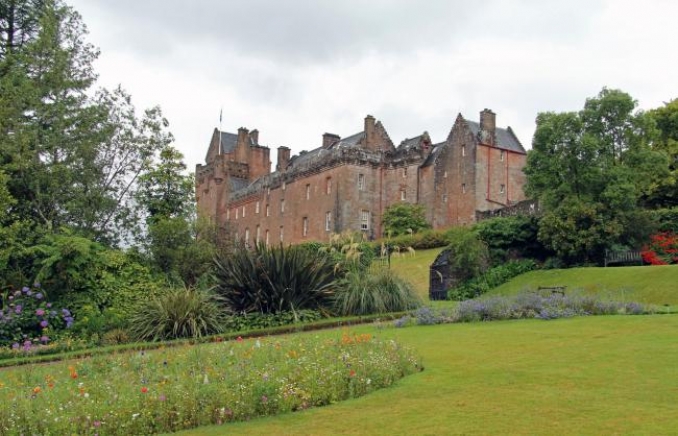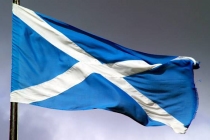Brodick Castle

Brodick Castle is located close to the port of Brodick, Isle of Arran, Scotland (Scottish Gaelic: Tràigh a' Chaisteil, Eilean Arainn, Alba). This is an island in the Firth of Clyde. The history of a fortress on this site can be traced back to the fifth century and the present structure dates to the early sixteenth century. The castle and gardens are now owned by the National Trust for Scotland. The Isle of Arran has rich history dating back to pre-history and onwards to the Gaeic kingdom of Dál Riata. It has strong Goidelic and Norse influences and at one time was part of the Kingdom Mann and the Isles which from the ninth to the thirteenth centuries comprised of the Hebrides, the islands of the Firth of Clyde and the Isle of Man. They were known to the Norse as Sudreyjar (Southern Isles) with Nodrejar (Northern Isles) comprising of Orkney and Shetland).
After the English King Edward I invaded Scotland in 1296 an English garrison was stationed at Brodick. It was in Arran that Robert the Bruce was said to have been inspired by a spider when forced into hiding after his coronation as King Robert I of Scotland. When watching the spider never give up as it sought to spin its web, Robert determinded to continue his battle against the English. In 1307 Robert the Bruce asked James Douglas, Lord of Douglas, to attack English forces supplying Brodick Castle. He was later able in 1307 to dislodge the English from Brodick, one of the first castles to fall to him in the long struggle to regain Scotland for the Scottish. In later years the castle was to again come under attack by the Enlish when in 1406 it was badly damaged by an English force that had sailed into Brodick bay. The castle suffered further damage by John of Islay, Lord of the Isles, in 1455. At some point after 1470 the castle was granted by James III to his brother-in-law, James Hamilton, 1st Lord Hamilton. His son, James Hamilton, 2nd Lord Hamilton was created Earl of Arran in 1503.
He had rebuilt the castle by 1510 in the form of a tower house, but it was again damaged in conflicts with the Campbells and the MacLeans. During the period known as the "Rough Wooing" (December 1543 – March 1551) which was part of the Anglo-Scottish Wars of the 16th century. Brodick Castle was attacked by an English force led by the Earl of Lennox on behalf of Henry VIII. It was during the tenure of James Hamilton, Duke of Châtellerault, 2nd Earl of Arran (c. 1519 – 1575), that some elnargement and expansion of the castle took place. The next major building work was at the time of William, 11th Duke of Hamilton. In 1844, massive building work was undertaken at the castle, almost tripling the size of the building, under the architect James Gillespie Graham. After the 11th Duke died his son William Douglas-Hamilton, 12th Duke of Hamilton inherited the castle. After him the castle passed to his only daughter the Lady Mary Louise Douglas-Hamilton. She married James Graham, 6th Duke of Montrose in 1906, and so it was, after more than five hundred years Brodick castle passed out of the Hamilton family.
The Castle and gardens were acquired by the National Trust for Scotlland in 1958. The castle is now open to the public during the summer, with Brodick Country Park open all year round. Broderick Castle, Garden and Country Park are now a popular tourist attraction and details can be found on the link below.
Link: Broderick Castle, Garden and Country Park.
Celtic nation:
- Scotland
Itinerary:
- Scotland Isle of Arran
Place type:
- Castle





